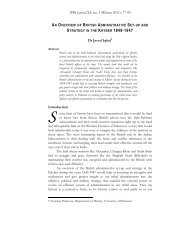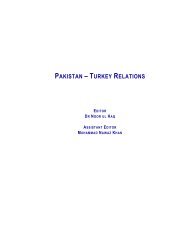120 Whither Kashmir? (Part II) - Islamabad Policy Research Institute
120 Whither Kashmir? (Part II) - Islamabad Policy Research Institute
120 Whither Kashmir? (Part II) - Islamabad Policy Research Institute
You also want an ePaper? Increase the reach of your titles
YUMPU automatically turns print PDFs into web optimized ePapers that Google loves.
<strong>Whither</strong> <strong>Kashmir</strong>?<br />
INDIA’S SILENT AGGRESSION<br />
India maintains a huge military machine in Occupied <strong>Kashmir</strong>, much<br />
larger than the United States and its allies, put together, have in Iraq and<br />
Afghanistan. In there, its three-quarters of a million troops are perhaps<br />
out number any such expeditionary force stationed in an occupied or<br />
disputed area since the Second World War. On the face of it, the<br />
deployment is tasked to deal with freedom fighters, which of course is a<br />
daunting challenge, but more importantly, it is there to change the face of<br />
the Muslim-majority landscape called <strong>Kashmir</strong>; its main weapon being<br />
brutal use of force against unarmed civilian population. But where its<br />
work goes almost unnoticed is the security it provides to Indian<br />
engineers, who are planning and working day and night to build dams on<br />
rivers that take water to Pakistan. So furiously are they working and in<br />
such so-far inaccessible areas that of late, New Delhi is thinking of<br />
bringing these projects under the enhanced protection cover of the<br />
Central Industrial Security Force (CISF). All this work falls within the<br />
definition of an aqua war India is preparing to foist on Pakistan, courtesy<br />
a Chanakiya manoeuvre to ‘turn Pakistan into a desert’. Not that<br />
Pakistanis are not aware of Indian designs; there is plenty of information<br />
how India is trying to dam up rivers Jhelum, Chenab and Indus, whose<br />
waters under the Indus Water Treaty should reach Pakistan<br />
uninterrupted. According to reports, India is planning or building some<br />
three dozen big and small hydropower projects and reservoirs on the<br />
tributaries of these principal rivers, including quite a few mega-projects,<br />
keeping Pakistan completely un-informed or misinformed.<br />
One of these is Bursar Dam on River Chenab, for which New<br />
Delhi has invited bids for a ‘topographical survey’. Others in different<br />
stages of planning/construction include Kishenganga on River Neelam,<br />
Uri Todium on River Pooch, which is tributary for River Jhelum and;<br />
the Baglihar, Dul Husti and Salal dams on River Chenab. On River<br />
Indus, the Indian engineers are working to steal water at Kargil and from<br />
its 12 distributaries. Not content with depriving Pakistan of its waters<br />
from <strong>Kashmir</strong>, the Indians have recently stepped up their aid-assisted<br />
work in Afghanistan on two dams on River Kabul, which is a tributary<br />
of River Indus. Yes, Pakistanis know all this - and much more, given the<br />
fact that the growing water shortages are causing problems that have<br />
begun negatively impacting provincial harmony, power generation and<br />
industrial production. As Irsa stood bitterly divided over the opening of<br />
49




